I’m ready for my closest monkey! Incredible moment as huge silverback gorilla emerges from the bushes among stunned tourists and then poses for photos during Rwanda safari
This is the incredible moment a huge silverback gorilla emerged from the bush inches away from stunned tourists before posing for photos during a safari in Rwanda.
Video shows a group of seven tourists sitting next to park rangers in Volcanoes National Park, northwestern Rwanda, when suddenly the large male ape walks towards them.
You see one tourist quickly leave the gorilla’s path, missing him by just inches, before the silverback moves up the hill and into the deep undergrowth making deep rumbling sounds – a sign of contentment.
The astonished tourists, overwhelmed by what they had just seen, squealed with excitement as they were heard saying, “Oh my god.”
Another clip shows the silverback mountain gorilla, named Lisaga, moving back toward the tourists and sitting in front of them before posing for photos.
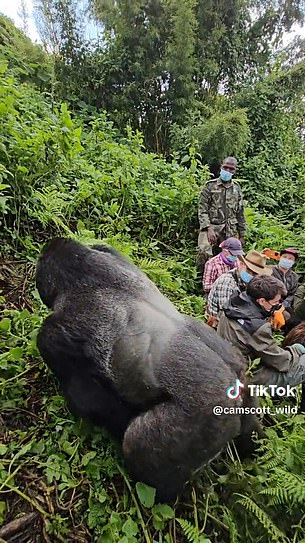
Video shows a group of seven tourists sitting next to park rangers in Volcanoes National Park, northwestern Rwanda, when suddenly the large male ape walks up to them
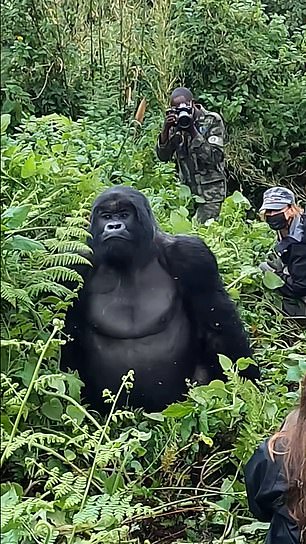
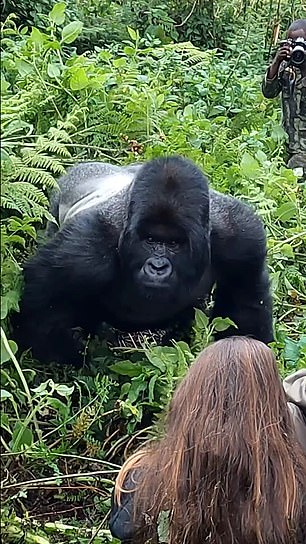
Another clip shows the silverback mountain gorilla, named Lisaga, moving back towards the tourists and sitting in front of them before posing for photos
In the background you can hear a guide laughing as the enormous animal appears to strike striking poses for the cameras.
The footage was taken by Cameron Scott, who runs tour company Royal Ngala Safaris, in the Volcanoes National Park.
“Life-changing meeting with Silverback,” Cameron said. ‘A moment that my guests will never forget. A large Silverback Mountain Gorilla emerges just a few feet away from my clients and then shows off its majestic beauty in a powerful yet graceful manner.”
“These moments in the wild are what it’s all about and we couldn’t be more grateful to all the rangers, trackers and conservationists behind the scenes who make it all possible,” Cameron added.
After posing for photos for the tourists, you see the silverback march past them – straight towards where Cameron was standing.
The quick-thinking guide pushed himself backwards into the thick brush, successfully creating enough space for the gorilla to move past him into the undergrowth.
‘If a huge Silverback decides to move, you quickly get out of the way. In this particular circumstance, I had my back to thick bushes with nowhere else to go. It was certainly a close encounter,” Cameron said.
Volcanoes National Park covers 160 square kilometers of rainforest and is home to the largest number of mountain gorillas in the wider Virunga Conservation area.
The national park was established to protect mountain gorillas, which were threatened with extinction due to poaching and war.
Within Volcanoes National Park, tour groups are limited to eight people at a time, with only one hour spent observing gorillas.
Tourists should not carry food or even water bottles near the animals, otherwise a curious silverback could snatch them away and perhaps be exposed to your germs.
And tourists are told not to maintain eye contact for too long. And if a gorilla acts aggressively – which is rare – look down, bend your knee and show that you acknowledge its authority.
This is why in Cameron’s video you see some tourists avert their gaze after a while and look down.
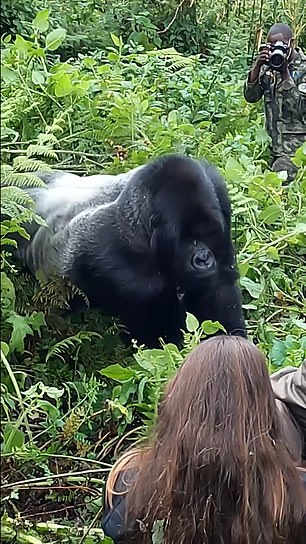
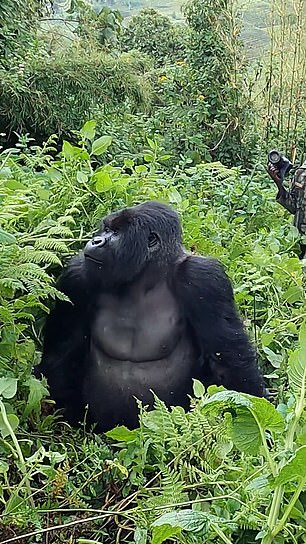
Another clip shows the silverback mountain gorilla, named Lisaga, moving back towards the tourists and sitting in front of them before posing for photos
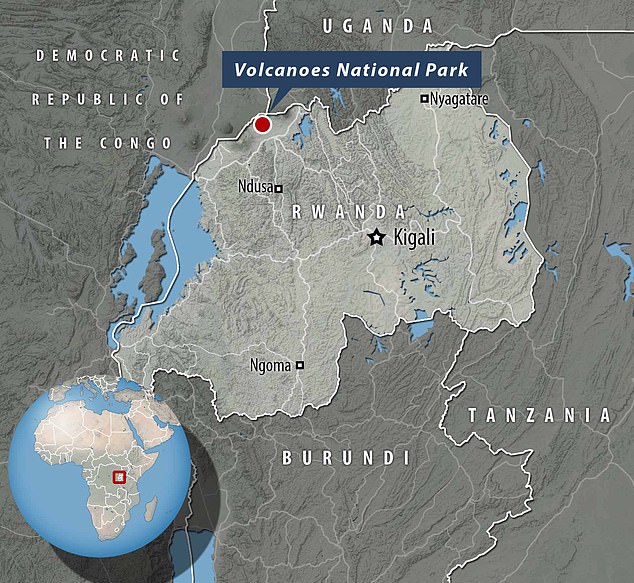
Volcanoes National Park covers 160 square kilometers of rainforest and is home to the largest number of mountain gorillas in the wider Virunga Conservation Area
American primatologist Dian Fossey had predicted the species would become extinct in 2000 before dying off in 1985. Before her death, she created the world’s longest-running study of gorillas in Volcanoes National Park.
And thanks to a concerted and sustained conservation campaign, experts have averted the worst and given a second chance to these great apes, who share about 98% of human DNA.
In 2018, the Switzerland-based International Union for the Conservation of Nature changed the status of mountain gorillas from “critically endangered” to “endangered,” an improved but still vulnerable designation, reflecting new research data.
This wouldn’t have happened without an intervention that some biologists call “extreme conservation,” which involved monitoring every single gorilla in the rainforest, providing them with periodic veterinary care – for example to clean infected wounds – and funding forest protection by sending money to communities that might otherwise resent not being able to convert forests to cropland.
Instead of disappearing, the number of mountain gorillas – a subspecies of eastern gorillas – has increased from 680 a decade ago to just over 1,000.
Their population is split between two regions, including the mist-covered, defunct volcanoes in Congo, Uganda and Rwanda – one of Africa’s smallest and most populous countries.
“The mountain gorilla population is still vulnerable,” says George Schaller, a renowned biologist and gorilla expert. “But their numbers are growing now, and that is remarkable.”
Once depicted in legends and films like “King Kong” as fearsome beasts, gorillas are actually languid primates that eat only plants and insects, and live in fairly stable, extended family groups. Their strength and chest-thumping are generally reserved for matches between male rivals.
